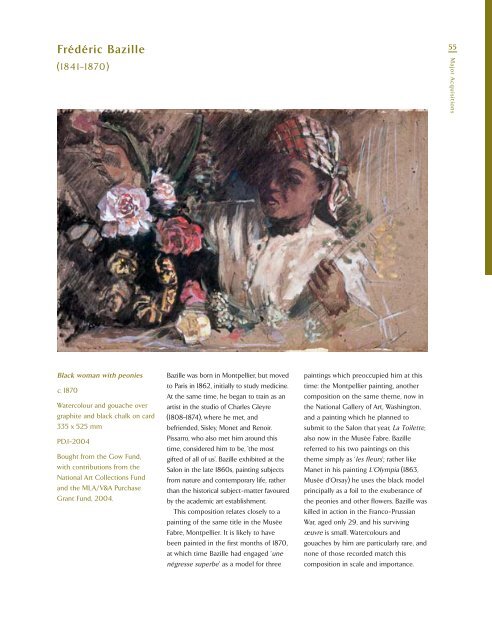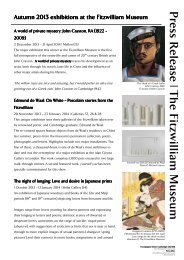The Fitzwilliam Museum - University of Cambridge
The Fitzwilliam Museum - University of Cambridge
The Fitzwilliam Museum - University of Cambridge
Create successful ePaper yourself
Turn your PDF publications into a flip-book with our unique Google optimized e-Paper software.
Frédéric Bazille<br />
(1841–1870)<br />
Black woman with peonies<br />
c. 1870<br />
Watercolour and gouache over<br />
graphite and black chalk on card<br />
335 x 525 mm<br />
PD.1–2004<br />
Bought from the Gow Fund,<br />
with contributions from the<br />
National Art Collections Fund<br />
and the MLA/V&A Purchase<br />
Grant Fund, 2004.<br />
Bazille was born in Montpellier, but moved<br />
to Paris in 1862, initially to study medicine.<br />
At the same time, he began to train as an<br />
artist in the studio <strong>of</strong> Charles Gleyre<br />
(1808–1874), where he met, and<br />
befriended, Sisley, Monet and Renoir.<br />
Pissarro, who also met him around this<br />
time, considered him to be, 'the most<br />
gifted <strong>of</strong> all <strong>of</strong> us'. Bazille exhibited at the<br />
Salon in the late 1860s, painting subjects<br />
from nature and contemporary life, rather<br />
than the historical subject-matter favoured<br />
by the academic art establishment.<br />
This composition relates closely to a<br />
painting <strong>of</strong> the same title in the Musée<br />
Fabre, Montpellier. It is likely to have<br />
been painted in the first months <strong>of</strong> 1870,<br />
at which time Bazille had engaged ‘une<br />
négresse superbe’ as a model for three<br />
paintings which preoccupied him at this<br />
time: the Montpellier painting, another<br />
composition on the same theme, now in<br />
the National Gallery <strong>of</strong> Art, Washington,<br />
and a painting which he planned to<br />
submit to the Salon that year, La Toilette,<br />
also now in the Musée Fabre. Bazille<br />
referred to his two paintings on this<br />
theme simply as ‘les fleurs’; rather like<br />
Manet in his painting L’Olympia (1863,<br />
Musée d’Orsay) he uses the black model<br />
principally as a foil to the exuberance <strong>of</strong><br />
the peonies and other flowers. Bazille was<br />
killed in action in the Franco-Prussian<br />
War, aged only 29, and his surviving<br />
œuvre is small. Watercolours and<br />
gouaches by him are particularly rare, and<br />
none <strong>of</strong> those recorded match this<br />
composition in scale and importance.<br />
55<br />
Major Acquisitions

















